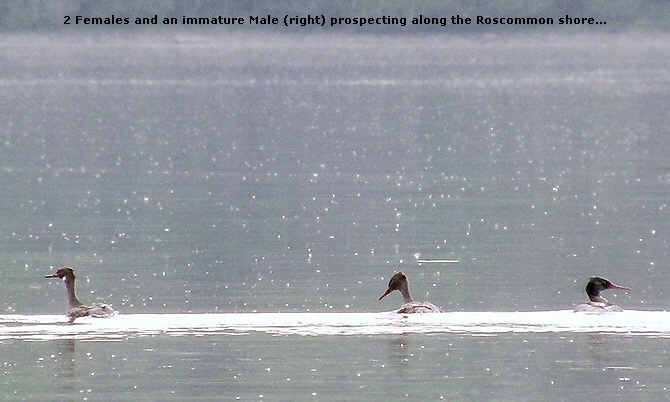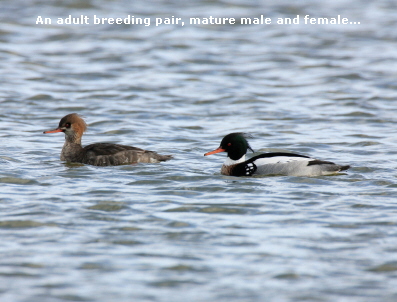|

|
TALA 7: [This is one of several pages published under this heading by LoughAllenBasin.com We endeavour to highlight what this area of NorthWest Ireland has to offer as a place to live, a place where interesting Plants and Animals may be found, and as a quiet peaceful location for Hi Tech Enterprise.]
BACK (to Index for this Section.) NEXT Topic (Flower Meadow) Lough Allen Basin HOME
loughallenbasin.com
|
|
UPDATE: A Species Study including 2011 data
is now available HERE
|
7. Study of Merganser Courtship and Distribution in Lough Allen (Summer 2010)
Typical Allen species... Healthy Population... Nest requirments
This Page has been updated. The Map below shows all our records for 2010.
“Lough Allen’s
beloved Mergansers
are back in town!”
First records of Mergansers from Lough Allen for Spring, 2011. One pair has been seen flying around the Corry Island area on 28th of March. Many more will probably arrive in areas shown on the Map shortly. We would appreciate any records people see from the area. Many thanks to Sligo Birding for their help in trying to co-ordinate records of birds leaving the sea recently.
(30th March 2011)
|
|
Location: Lough Allen
Lough Allen has a record as a breeding location for Red Breasted Mergansers. A bird of the west coast and a regular visitor all around Ireland in the Winter, this is a charismatic and interesting species.
As part of the thesis that... Lough Allen is a very special place... we see it as one of the important Birds that establish and justify that claim, along with Lapwings, Common Sandpipers, Common Gulls et al.
The purpose of this page is to report results to date, to ask for any records people around the Lake may have, and to increase public awareness of this attractive and distinctive breeding bird that is more at home in Lough Allen than in many other lakes... Why is that?
The MAP:
There is a lot of detail on this Map. Breeding evidence for Mergansers may be circumstantial. They are very wild and do not appreciate disturbance. So it’s best not to go near breeding areas at critical times. We deduce from this Map, and from observations of young birds (unfortunately few in 2010), how the breeding season is going for them.
(Go to VIEW / ZOOM in your Browser if you wish to study fine detail in the map!)
Please note that records for the same group of birds on the same
day (i.e. same colour dot), are probably the same birds!
Colour Variations: The normal appearance of a green-headed male and a chestnut-headed female are well known. But commonly found in Lough Allen are non-breeding males with darker brown heads and more white on the wing. These are found throught the Summer and we do not know when they adopt the green head of the ‘breeding’ male. In their first year they are active with young females in prospecting for nesting sites, often in the less favourable areas not occupied by more experienced couples!
What’s special about Mergansers?
Mergansers are Sawbills, that group of Ducks that dive and catch fish (though not in any significant amount in a lake the size of Lough Allen). Mergansers breed in freshwater but winter on the sea. Most of our other ducks are Dabbling Ducks like the Mallard, Teal, and Tufted Ducks, also found in Lough Allen. Mergansers are the only member of their tribe to commonly breed in Ireland and Lough Allen is an important base for them. They are also a very atractive and interesting duck to watch. A related species, The Goosander, has started to breed in Wicklow in very small numbers. It is important that we protect our Mergansers here as they are typical of Lough Allen and are very much on the edge of their range.
|
|
|
|
Distribution.
Well, Mergansers are definitely breeding around Lough Allen. The question is, how many pairs? When we started our survey in early April the population seemed low. However, with each day they seem to be becoming more numerous and more active. This is great news as, never before have we seen so many of these ‘Lough Allen specialities’ in the Lake. The weather has been particularly favourable, with a long spell of dry weather and low water levels. Mergansers need a constant water level to successfully establish a pairing, lay eggs, and incubate the eggs to hatching. Like many other of Lough Allen’s unique flora and fauna they are very vulnerable to the ever increasing flooding of Lough Allen.
The Map on the left shows the result of our work to date. We hope by plotting the position, sex, and movements of individuals and groups of Mergansers around the lake, we will soon be able to identify a pattern of nesting locations and numbers of breeding pairs. The Birds do seem to favour areas to the north and south of the lake but the hole in the middle of the map also reflects our survey pattern to date. It is, of course, intended to complete a survey of the middle sections of the Lake during this year.
|
|
Courtship and Display: |
|
Breeding: |
|
|
A pair of Mergansers was recently seen courting and mating (MF b on the Map above) on the north shore of Lough Allen. They were also coming ashore at the same time, maybe in a search for a nesting location. The ritual observed can be described as follows:
This pair at first seemed to be fishing, both of them diving regularly but only for very short periods. He then started cruising along with his bill just in the water while she kept on diving... but they weren’t catching anything, just showing off!
|
|
Risks to Breeding.
Mergansers are not very vulnerable to attack but their shyness and extreme secrecy suggest that they are not without their enemies such as Mink, Gulls, Crows. They are not persecuted by Man and there seems to be abundant fish available to them. Lough Allen has always had clean water and should be fairly immune from pollution because of the low population pressure from the surrounding counties. However, the lake shore suffers from frequent unsightly displays of rubbish (which should be tackled) and which may pose a threat of injury to this species.
However, the main threat to successful breeding is a largely natural one... excessive Summer rainfall flooding nests while eggs are still present. Some might say that this is NOT a totally natural phenomen! Also Lough Allen is a regulated Lake with sluices controlling the release of water into the Shannon at its south western corner. Sometimes these sluices may have to be closed to limit disastrous flooding lower down the Shannon. But we would plead with the Authorities to try (as much as possible) to keep Lough Allen’s Summer water levels constant and as low as possible... for the sake of Lough Allen’s rare nesting birds, some of which are listed species, as well as its unique and important Flora (including the very rare Irish Lady’s Tresses found here and in Scotland but nowhere else in Europe or Asia!)
|
|
After much mock fishing both parties started to flirt with bills pointing up and crests raised. They tended to swim (dance) around one another. Ater a while the female lowered herself very low in the water so that it was actually flowing around the base of her neck. This clearly seemed to be an invitation to mate but, just when you’d expect the boy to become eager, he held off! Keeping a certain distance he continually swam behind the female until temptation became too strong and he swam over to her and succumbed to her invitation. Mating took place in the water.
|
|
Breeding Behaviour.
We now know that breeding is planned and eggs are probably being laid. If the weather remains stable we anticipate the Mergansers will have a successful breeding season in 2010. In previous years, Birds have been seen with both large broods and just individual ducklings. Whether this is due to nest flooding, predation of the eggs or chicks, or some other factor... we simply don’t know. However there has been a pattern of rising Summer water levels on the Lake, a feature often remarked upon by long term residents of the area.
Mergansers nest on the ground, very close to the waters edge, typically in among trees and under exposed roots. Little can be done to protect nests as work in other countries has shown that they seem very reluctant to go far away from water or to climb up above it. Other related species are tree nesters and are well protected from floods, but not the Merganser.
Courtship has been observed from the 11th. of May when a pair were seen displaying and mating in the Corry area at the north of the Lake. The elaborate courtship behaviour was closely observed but not close enough to get good photographs. The sketches on the left are produced following these observations. Subsequently a pair were seen flying into the Ross More inlet and only the male flying back out shortly afterwards. Was the female busy laying eggs? Subsequently another pair (or, indeed, the same pair) was seen going ashore near Corry Point a bit further to the west. Such behaviour would suggest they were scouting for a nest site or in the process of laying a clutch.
|
|
|

Other Interesting Behaviour.
Particularly at the southern end of the Lake there seem to be some non-breeding or immature Males present. Precise numbers are hard to count as they quickly move from one side of the Lake to the other (as indicated by the blue arrows on our Map). The immature (or non-breeding males) are recognisable by dark brown heads as opposed to green heads in the breeding males at this time of year. Some books refer to these birds as immature (ie. last years chicks); others call them non-breeding. But we find it hard to understand how not breeding might change your head feathers! So we assume these males are young birds from last year. They associate with females who are identical in appearance to the breeding females, but which may also be young birds prospecting for breeding sites.
There is also a common association between breeding males and these young prospecting 1st year Mergansers. We have seen a green-headed male on several occasions associating and apparently competing with a non-breeding male only to leave them suddenly and return to an area where a breeding pair has been known to occur. This raises the intriguing possibility of whether these birds could be related or whether it is just territorial competition. Mergansers occur in the sea mainly during the Winter period and maybe these are family parties that hatched on Lough Allen in previous years and have returned in the Spring to breed again?
|
|
|
|
|
|
|
 Population? Population?
So how many Breeding Pairs are there in Lough Allen, and how many non-breeders? We simply don’t know; does anyone? Certainly this year, at this time,they are actively courting and actively prospecting for breeding sites. There also seems to be a healthy population of first year birds and signs of pair formation and territorialism among these. Hopefully, weather permitting, it will be a good year for Lough Allen’s Mergansers.
BACK to Section index.
NEXT Field Report. A Leitrim Flower Meadow full of colour, biodiversity and some rare plants and animals.
|
|
|
|
|
|
|
[MORE TRIPS to come! Including some from earlier dates than this one!]
If you have any interesting records of animals or plants from the Lough Allen basin, we will be very pleased to reproduce them here.
|